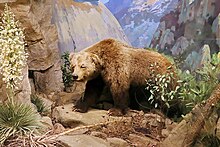
Back Rupol (Ursus arctos californicus) AVK Kaliforniya qonur ayısı Azerbaijani Os grizzly de Califòrnia Catalan Californisk grizzlybjørn Danish Ursus arctos californicus Spanish خرس گریزلی کالیفرنیا Persian Grizzly de Californie French Beruang cokelat california ID Ursus arctos californicus Italian カリフォルニアハイイログマ Japanese
| California grizzly bear | |
|---|---|

| |
| Specimen at the Santa Barbara Museum of Natural History | |
| Scientific classification | |
| Domain: | Eukaryota |
| Kingdom: | Animalia |
| Phylum: | Chordata |
| Class: | Mammalia |
| Order: | Carnivora |
| Family: | Ursidae |
| Genus: | Ursus |
| Species: | U. arctos |
| Subspecies: | †U. a. californicus |
| Trionomial name | |
| †Ursus arctos californicus (Merriam, 1896) [2] | |
| Synonyms | |
|
List:
| |
The California grizzly bear (Ursus arctos californicus[3]), also known as the California golden bear,[4] is an extinct population of the brown bear,[5] generally known (together with other North American brown bear populations) as the grizzly bear. "Grizzly" could have meant "grizzled" – that is, with golden and grey tips of the hair – or "fear-inspiring" (as a phonetic spelling of "grisly").[6][7] Nonetheless, after careful study, naturalist George Ord formally classified it in 1815 – not for its hair, but for its character – as Ursus horribilis ("terrifying bear").[8] Genetically, North American brown bears are closely related;[9] in size and coloring, the California grizzly bear was much like the Kodiak bear of the southern coast of Alaska. The grizzly became a symbol of the Bear Flag Republic, a moniker that was attached to the short-lived attempt by a group of U.S. settlers to break away from Mexico in 1846. Later, this rebel flag became the basis for the state flag of California, and then California was known as the "Bear State".[10]
- ^ IUCN (February 2, 2016). "Ursus arctos: McLellan, B.N., Proctor, M.F., Huber, D. & Michel, S.: The IUCN Red List of Threatened Species 2017: e.T41688A121229971". doi:10.2305/iucn.uk.2017-3.rlts.t41688a121229971.en. Retrieved October 7, 2023.
- ^ Merriam 1896, pp. 76–77
- ^ Mychajliw, Alexis M.; Adams, Andrea J.; Brown, Kevin C.; Campbell, Beau T.; Hardesty-Moore, Molly; Welch, Zoë S.; Page, Henry M.; Southon, John R.; Cooper, Scott D.; Alagona, Peter S. (2024). "Coupled social and ecological change drove the historical extinction of the California grizzly bear (Ursus arctos californicus)" (PDF). Proceedings of the Royal Society B. 290 (2014) 20230921. doi:10.1098/rspb.2023.0921. PMC 10777157. PMID 38196370.
- ^ Hall, E. Raymond (August 10, 1984), "Geographic variation among brown and grizzly bears (Ursus arctos) in North America", Special publication 13, University of Kansas Museum of Natural History, retrieved September 24, 2011
- ^ "Ursus arctos. NatureServe Explorer 2.0". explorer.natureserve.org. Retrieved September 14, 2023.
- ^ Wright, William Henry (1909), The Grizzly Bear: The Narrative of a Hunter-naturalist, Historical, Scientific and Adventurous
- ^ Rose, Ian (April 25, 2024). "Frontier myth vilified the California grizzly. Science tells a new story". The Washington Post. Retrieved April 27, 2024.
- ^ Grisly indeed, Grizzly Island was aptly named". Daily Republic. Retrieved 5 May 2011.
- ^ Miller, C.; Waits, L.; Joyce, P. (2006). "Phylogeography and mitochondrial diversity of extirpated brown bear (Ursus arctos) populations in the contiguous United States and Mexico". Mol Ecol. 15 (14): 4477–4485. Bibcode:2006MolEc..15.4477M. doi:10.1111/j.1365-294X.2006.03097.x. PMID 17107477. S2CID 7336900.
- ^ Storer, T.I.; Tevis, L.P. (1996). California Grizzly. Berkeley, CA: University of California Press. ISBN 978-0-520-20520-8. Archived from the original on September 7, 2012.
© MMXXIII Rich X Search. We shall prevail. All rights reserved. Rich X Search
